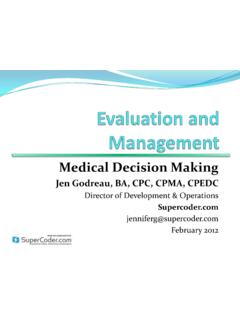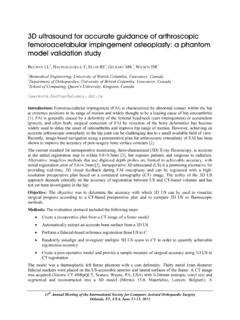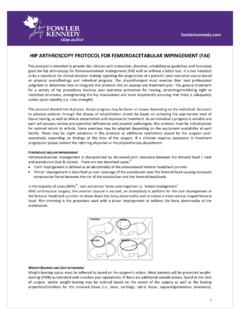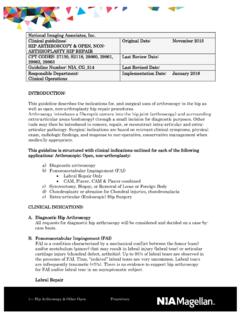Transcription of Surgical Treatment of Femoroacetabular Impingement
1 Medical Policy 1 Surgical Treatment of Femoroacetabular Impingement Section Surgery Effective Date August 29, 2014 Subsection Surgery Original Policy Date July 1, 2011 Next Review Date August 2015 Description Femoroacetabular Impingement (FAI) results from localized compression in the joint due to an anatomic mismatch between the head of the femur and the acetabulum. Symptoms of Impingement typically occur in young to middle-aged adults before the onset of osteoarthritis but may be present in younger patients with developmental hip disorders. The objective of Surgical Treatment of FAI is to improve symptoms and reduce further damage to the joint.
2 Related Policies Hip Resurfacing Policy Open or arthroscopic Treatment of Femoroacetabular Impingement (FAI) is considered medically necessary when all of the following are met: Candidates should be skeletally mature with documented closure of growth plates ( , >15) All of the following symptoms: o Moderate-to-severe hip pain that is worsened by flexion activities ( , squatting or prolonged sitting) that significantly limits activities o Unresponsive to conservative therapy for at least 3 months (including activity modifications, restriction of athletic pursuits, and avoidance of symptomatic motion) o Positive Impingement sign on clinical examination (pain elicited with 90 degrees of flexion and internal rotation and adduction of the femur) All of the following imaging.
3 O Morphology indicative of cam or pincer-type FAI, ( , pistol-grip deformity, femoral head-neck offset with an alpha angle greater than 50 degrees, a positive wall sign, acetabular retroversion [overcoverage with crossover sign], coxa profunda or protrusion, or damage of the acetabular rim) Medical Policy 2o High probability of a causal association between the FAI morphology and damage, ( , a pistol-grip deformity with a tear of the acetabular labrum and articular cartilage damage in the anterosuperior quadrant) o No evidence of advanced osteoarthritis, defined as Tonnis grade II or III, or joint space of less than 2 millimeters o No evidence of severe (Outerbridge grade IV) chondral damage Treatment of Femoroacetabular Impingement is considered investigational in all other situations.
4 Policy Guidelines If Femoroacetabular Impingement (FAI) morphology is identified, patients should be advised not to play aggressive sports. No more frequent than annual follow-up with magnetic resonance (MR) arthrography may be indicated for FAI morphology to evaluate cartilage changes before damage becomes severe. It should be noted that current imaging techniques limit the early identification of cartilage defects, whereas delay in the Surgical correction of bony abnormalities may lead to disease progression to the point at which joint preservation is no longer appropriate. Confirmation of subtle FAI morphology may require 3-D CT.
5 Some clinicians may also use local anesthetic injection into the joint to assist in confirming FAI pathology. Treatment of FAI should be restricted to centers experienced in treating this condition and staffed by surgeons adequately trained in techniques addressing FAI. Because of the differing benefits and risks of open and arthroscopic approaches, patients should make an informed choice between the procedures. Some patients may require a second procedure if they have persistent or recurrent symptoms and meet the criteria for Treatment of FAI. Published studies indicate that not all sources of Impingement may have been identified before surgery, and those that had been identified may not have been adequately treated.
6 The risk of needing an additional Surgical procedure can be reduced by intraoperative assessment of Impingement after bone debridement and reshaping. Coding There are specific CPT codes for the arthroscopic Treatment of FAI: 29914: Arthroscopy, hip, Surgical ; with femoroplasty ( , Treatment of cam lesion) 29915: Arthroscopy, hip, Surgical ; with acetabuloplasty ( , Treatment of pincer lesion) 29916: Arthroscopy, hip, Surgical ; with labral repair There are no specific CPT codes for the open Treatment of FAI. The procedure may be coded using CPT code: 27299: Unlisted procedure, pelvis or hip joint There is no specific ICD-9-CM diagnosis code for FAI.
7 It may be coded using: : Unspecified disorder of joint of pelvic region and thigh Medical Policy 3 Benefit Application Benefit determinations should be based in all cases on the applicable contract language. To the extent there are any conflicts between these guidelines and the contract language, the contract language will control. Please refer to the member's contract benefits in effect at the time of service to determine coverage or non-coverage of these services as it applies to an individual member. Some state or federal mandates ( , Federal Employee Program (FEP)) prohibit Plans from denying Food and Drug Administration (FDA) - approved technologies as investigational.
8 In these instances, plans may have to consider the coverage eligibility of FDA-approved technologies on the basis of medical necessity alone. Rationale Femoroacetabular Impingement (FAI) arises from an anatomic mismatch between the head of the femur and the acetabulum, causing compression of the labrum or articular cartilage during flexion. The mismatch can arise from subtle morphologic alterations in the anatomy or orientation of the ball-and-socket components (for example, a bony prominence at the head-neck junction or acetabular overcoverage) with articular cartilage damage initially occurring from abutment of the femoral neck against the acetabular rim, typically at the anterosuperior aspect of the acetabulum.
9 Although hip joints can possess the morphologic features of FAI without symptoms, FAI may become pathologic with repetitive movement and/or increased force on the hip joint. High-demand activities may also result in pathologic Impingement in hips with normal morphology. Two types of Impingement , known as cam Impingement and pincer Impingement may occur alone or, more frequently, together. Cam Impingement is associated with an asymmetric or nonspherical contour of the head or neck of the femur jamming against the acetabulum, resulting in cartilage damage and delamination (detachment from the subchondral bone). Deformity of the head/neck junction that looks like a pistol grip on radiographs is associated with damage to the anterosuperior area of the acetabulum.
10 Symptomatic cam Impingement is found most frequently in young male athletes. Pincer Impingement is associated with overcoverage of the acetabulum and pinching of the labrum, with pain more typically beginning in women of middle age. In cases of isolated pincer Impingement , the damage may be limited to a narrow strip of the acetabular cartilage. It has been proposed that Impingement with damage to the labrum and/or acetabulum is a causative factor in the development of hip osteoarthritis and that as many as half of cases currently categorized as primary osteoarthritis may have an etiology of FAI. Previously, access to the joint space was limited, and Treatment primarily consisted of debridement and/or labral reattachment.



















